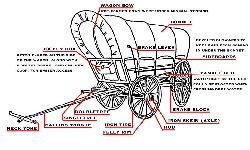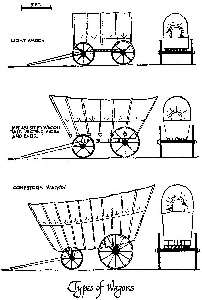Wagon Peoples
Wagon Facts & Terminology
Conjecture and Just for Fun
The information on this page is not being presented as being "Gorean," or as being wagons of the Alar, the Wagon Peoples, or any others on Gor. Rather, this page is designed to help those unfamiliar with many aspects of wagons, such as structural design, to better "see" what a wagon on Gor may look like. There is a lot of supposition and debate on exactly what Earth counterparts would be similar to the various wagons found on Gor.
The Conestoga Wagon
When most of us think of wagons, the Conestoga comes to mind. These large wagons carried families out of the dustbowl of Oklahoma and to the green grass of the San Joaquin Valley in California. It's possible a wagon of this type is found on Gor perhaps among the peasant folks.
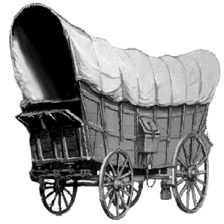 |
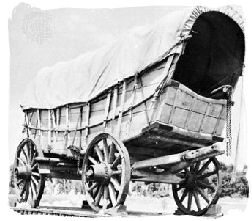 |
The Gypsy Wagons
The gypsy wagons are another wagon type that many of us might think of. Perhaps a version of this wagon would be found owned by the merchant caravans. There are a couple of known types of the gypsy wagon, most notably perhaps the wagons pictured below. Another form of this wagon is notable by the rounded dome. This is the wagon most noted among gypsies of Romany.
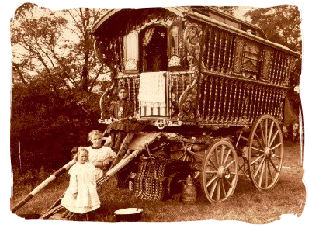 |
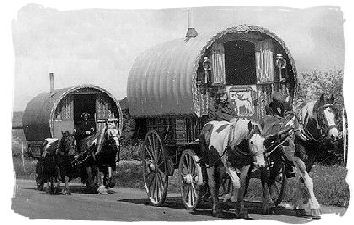 |
The Yurt
It's been supposed that the Yurt is the wagon of the four wagon tribes of the plains of Turian in Gor. Let's explore the yurt.
What is a Yurt?
Yurt is the name commonly used to refer to a Mongolian Felt Tent or  Ger. Mongolians generally dislike the term "yurt" because it is most often used by Western invaders. A Ger is really more than a tent. The Mongols live in them year round and tend to prefer them to other forms of housing. The design has been developed for generations to suit the needs of its inhabitants. It can be warm in arctic cold, yet cool in summer. The structure can collapse small enough to fit on one draft animal and can be set up again in a half an hour.
Ger. Mongolians generally dislike the term "yurt" because it is most often used by Western invaders. A Ger is really more than a tent. The Mongols live in them year round and tend to prefer them to other forms of housing. The design has been developed for generations to suit the needs of its inhabitants. It can be warm in arctic cold, yet cool in summer. The structure can collapse small enough to fit on one draft animal and can be set up again in a half an hour.
The Kyrgyz tent is an extraordinarily practical and pleasant dwelling. The interior is always cosy and inviting, one is constantly surrounded by pure, fresh air, one breathes more easily and the whole day long enjoys seeing a glimpse of the sky through the smoke outlet. Of an evening the stars come twinkling through the rising smoke, and the moon too peeps into our airy dwelling. I enjoyed myself in one word splendidly in these tents and would not have chosen to exchange them for Persia's best chaparkhaneh (Hedin 1893: 395).
Yurt
Etymology: Russian yurta, of Turkic origin; akin to Turkish yurt home, dwelling
"A circular domed tent consisting of skins or felt stretched over a collapsible lattice framework and used by the Kirghiz and other Mongol nomads of Siberia" — Merriam-Webster Dictionary ©2005-2006
By this definition, then the yurt is not a wagon, 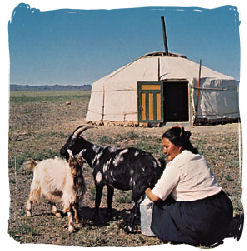 but rather is a tent. Therefore, would not be the base for the wagons of the plains nomads on Gor. Let's look further.
but rather is a tent. Therefore, would not be the base for the wagons of the plains nomads on Gor. Let's look further.
Also spelled yurta , Mongol ger tentlike Central Asian nomad's dwelling, erected on wooden poles and covered with skin, felt, or handwoven textiles in bright colours. The interior is simply furnished with brightly coloured rugs (red often predominating) decorated with geometric or stylized animal patterns. The knotted pile rug, first known from a nomad burial at the foot of the Altai Mountains (5th�3rd century BC), probably developed as a fur substitute to provide warmth and sleeping comfort in the yurt.
Other items found inside a typical yurt include saddlebags, drinking gourds, and tools for spinning and weaving. The yurt is pitched wherever the nomad finds good pasture for the herds and is carried from place to place on horseback or on a small wagon.
— Encyclopedia Brittanica ©2006
Yurt is a word of Russian origin describing a circular trellis walled framed tent. The roof supported by a conical or domed frame consisting of a number of ribs radiating from a central wooden wheel to the top of the wall trellis. The yurt is traditionally covered with felt, made by beating and rolling wet sheep fleece. There are three main types of yurt:
- The Kirgiz yurt with bent-wood roof poles and crown and a domed overall shape. Used by the Turkish speaking kirgiz, Kazak, Uzbek, and Turkmen people.
- The two tiered yurt with a pointed roof and two layers of wall section placed one on top of the other. Used by the Uzbek, and Arab peoples of Afghanistan.
- The Mongol or Kalmuk ger with straight roof poles, a heavy timber crown, often supported by two upright poles, and fitted with a wooden door.
The Mongolian Ger (describing a Mongolian's tent as a yurt may offend his/her national pride) is a versatile dwelling with a proven pedigree, being home to the nomads of central Asia for many centuries.  The oldest complete yurt yet discovered was in a 13th century grave in the Khentei Mountains of Mongolia. Discoveries at Pazaryk, Southern Siberia indicate that the technology to make yurts was in use during the 4th century BC. The BBC Horizon series "Ice Mummies" suggests that yurts were in use at this time. Throughout this time the design has changed little, the ger being perfectly suited to a nomadic lifestyle in one of the worlds most inhospitable climates, with high winds rain and snow, where winter temperatures regularly fall to -50�C. To this day it is still the preferred home to the majority of Mongolian people, the suburbs of the capital Ulaan Baatar consist entirely of gers. The use of the other two yurt types has declined greatly this century. This proven design is equally well suited to the many uses for moveable dwellings in this country. The yurt can be insulated for winter use, the sides rolled up to admit a cooling breeze on hot days. On clear nights one can lie in bed and watch the stars through the open crown. On wet nights there is plenty of room for a group of friends to sit in comfort around a warm stove, tell stories and listen to the storm outside. The atmosphere inside the yurt is one of warm, secure, solidity, while from the outside the yurt radiates a welcoming glow.
The oldest complete yurt yet discovered was in a 13th century grave in the Khentei Mountains of Mongolia. Discoveries at Pazaryk, Southern Siberia indicate that the technology to make yurts was in use during the 4th century BC. The BBC Horizon series "Ice Mummies" suggests that yurts were in use at this time. Throughout this time the design has changed little, the ger being perfectly suited to a nomadic lifestyle in one of the worlds most inhospitable climates, with high winds rain and snow, where winter temperatures regularly fall to -50�C. To this day it is still the preferred home to the majority of Mongolian people, the suburbs of the capital Ulaan Baatar consist entirely of gers. The use of the other two yurt types has declined greatly this century. This proven design is equally well suited to the many uses for moveable dwellings in this country. The yurt can be insulated for winter use, the sides rolled up to admit a cooling breeze on hot days. On clear nights one can lie in bed and watch the stars through the open crown. On wet nights there is plenty of room for a group of friends to sit in comfort around a warm stove, tell stories and listen to the storm outside. The atmosphere inside the yurt is one of warm, secure, solidity, while from the outside the yurt radiates a welcoming glow.
The nomad tent is both beautiful and practical. It keeps the heat out in the summer and the cold out in the winter. It does not like damp areas but can stand up to rain in moderate quantities. Yurts come in different sizes and they can be up to 10 to 12 metres in diameter. The colors vary between almost completely white to different shades of grey. The wealthiest individuals often have white yurts with beautiful woven bands at the upper edge and around the doors. These yurts are used mostly as decorative objects in that they are put up on the occasion of important visits, in connection with rituals or during festivals. The grey yurts on the other hand are utility objects that are used for example by herdsmen in the high mountains.
Despite the fact that during the last hundred years the yurt has only partly been used as a dwelling, the nomad tent has a central place in the lives of many Kyrgyz. The felt tent is a natural element at festivals and in connection with various rituals. At festivals the tent can be used as a showroom for Kyrgyz arts and crafts, as an eating place or accommodation for those taking part in the festival. The yurt is also an important element in the burial ritual. Before the actual funeral the deceased lies for three full days on a lit de parade in the tent. It is expected that family and friends will in the course of these days call in to tender their condolences and pay their last respects to the deceased. It is usual for deceased inhabitants of the capital to be transported to their family's village. Not until then are they placed in a yurt for three days before being buried in the family grave. If the deceased has no family ties in the countryside, a yurt may be placed in the courtyard or backyard of the tenement complex where the deceased lived.
Seen from the door the left side of the yurt is the man's and the right side is the woman's. In the woman's half we find the kitchen department where food is prepared and kitchen utensils stored. On the man's side are placed weapons, equestrian equipment and other things that belong to men.
What Are the Different Elements of a Ger?
- Lattice Walls (qana)
These walls are formed by several individual sections of cris crossed lattice work, much like baby gate. These wall sections were constructed of wooden poles joined together with leather lacing at the crossings. The number of crossings along the top would usually be from ten to fifteen. The number of crossings along the length of a pole would usually be thirteen, a number of spiritual significance. The wall sections are usually butted, meaning they end square with the use of shorter poles. Each wall section can obviously be collapsed to take up very little room. - Door
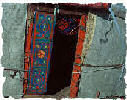 The door, with the two ends of the qana coming to meet on either side of its wooden framing, can be strikingly modern in appearance. It is usually constructed completely of wood but sometimes incorporates felt as well. The door's threshold is believed to contain the spirit of the house and it is forbidden, and a great offense to the ger's owner, to step on it.
The door, with the two ends of the qana coming to meet on either side of its wooden framing, can be strikingly modern in appearance. It is usually constructed completely of wood but sometimes incorporates felt as well. The door's threshold is believed to contain the spirit of the house and it is forbidden, and a great offense to the ger's owner, to step on it.
- Roof Ring (toghona)
The roof ring is the most complex element in ger construction. It is usually a hoop of wood containing slots or holes that the roof poles can lock into. The interior of the ring can contain many different designs but must be relatively open to allow smoke and air flow. During bad weather is it covered with a piece of felt or hide called an eruke). - Roof Poles (uni)
Roof poles are simply the wooden beams that form the roof skeleton. They are usually shaved down on one side to allow them hook into the roof ring. The other end of a roof pole is laid against the top of the qana or its lashings. - Felt (isegei)
Like all ger materials, this is manufactured local to Mongolia. In the states, we'd probably call this canvas. During really cold times of year, many layers might be used, including animal hides. This covering is secured using ropes. The ropes and felt are made from hair, human and other.
The Yurt of the Wagon Peoples of Gor
So where did these kooky notions come about that the yurt, or ger, is a wagon? The yurts are still simply tents mounted on a wagon platform. Upon reading the following quote, you will see how the wagon box is square (just like in the photos below), with the rounded, tentlike structure set within (the yurt). Because John Norman describes the wheels as similar to a Conestoga, is likely how many depict the wagons of the Turian plains.
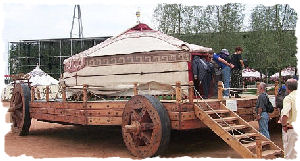 |
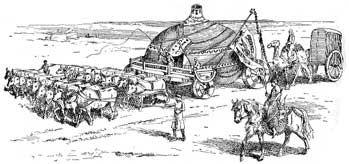 |
"The wagons of the Wagon Peoples are, in their hundreds and thousands, in their brilliant, variegated colors, a glorious sight. Surprisingly the wagons are almost square, each the size of a large room. Which is drawn by a double team of bosk, four in a team, with each team linked to its wagon tongue, the tongues being joined by tem-wood crossbars. The two axles of the wagon are also of tem-wood, which perhaps, because of its flexibility, joined with the general flatness of the southern Gorean plains, permits the width of the wagon.
The wagon box, which stands almost six feet from the ground, is formed of black, lacquered planks of tem-wood. Inside the wagon box, which is square, there is fixed a rounded, tentlike frame, covered with the taut, painted, varnished hides of bosks. These hides are richly colored, and often worked with fantastic designs, each wagon competing with its neighbor to be the boldest and most exciting. The rounded frame is fixed somewhat within the square of the wagon box, so that a walkway, almost like a ship's bridge, surrounds the frame. The sides of the wagon box, incidentally, are, here and there, perforated for arrow ports, for the small horn bow of the Wagon Peoples can be used to advantage not only from the back of a kaiila but, like the crossbow, from such cramped quarters. One of the most striking features of these wagons is the wheels, which are huge, the back wheels having a diameter of about ten feet; the front wheels are, like those of the Conestoga wagon, slightly smaller, in this case, about eight feet in diameter; the larger rear wheels are more difficult to mire; the smaller front wheels, nearer the pulling power of the bosk, permit a somewhat easier turning of the wagon. These wheels are carved wood and, like the wagon hides, are richly painted. Thick strips of boskhide form the wheel rims, which are replaced three to four times a year. The wagon is guided by a series of eight straps, two each for the four lead animals. Normally, however, the wagons are tied in tandem fashion, in numerous long columns, and only the lead wagons are guided, the others simply following, thongs running from the rear of one wagon to the nose rings of the bosk following, sometimes as much as thirty yards behind, with the next wagon; also, too, a wagon is often guided by a woman or boy who walks beside the lead animals with a sharp stick.
The interiors of the wagons, lashed shut, protected from the dust of the march, are often rich, marvelously carpeted and hung, filled with chests and silks, and booty from looted caravans, lit by hanging tharlarion oil lamps, the golden light of which falls on the silken cushions, the ankle-deep, intricately wrought carpets. In the center of the wagon there is a small, shallow fire bowl, formed of copper, with a raised brass grating. Some cooking is done here, though the bowl is largely to furnish heat. The smoke escapes by a smoke hole at the dome of the tentlike frame, a hole which is shut when the wagons move."
— Nomads of Gor, pages 30-31.
Wagon Design and Lay-Out
Below are various wagon designs and their layouts. To see the full-scle version of the diagrams, simply click on each one.
Wagon Terminology
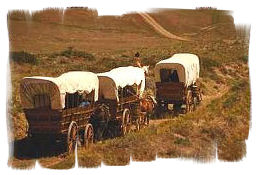
This list of wagon terms is purely for fun. Most of the terms don't apply to Gor, but some of the terms may surprise you. How many of these terms do you know? How many do you use in everyday language?
Boot
The baggage compartment at the rear of the stage and also under the driver's seat; it was made of leather.
Box
The stagecoach driver's seat.
Bull-Whacker
A driver of a freight wagon, usually with oxen.
Carry-All
A light, covered carriage holding several people.
Charlie
A stage coach driver.
Corduroy Road
A road created by logs laid across a swampy, low-lying area, placed together or "ribbed" like corduroy cloth.
Expressman
A messenger carrying express items.
Groom
A stableman, one who takes care of the horses.
Hame
One of two curved bars fitted to a horsecollar, holding the traces of a harness.
Hostler
A stableman.
Jehu (pronounced - "yahoo")
A stagecoach driver, taken from the name of a biblical character who drove fast and furiously.
Leaders
Horses leading a four- or six-horse hitch.
Lines
Reins.
Reaches
Bars connecting rear axles with forward part of the coach.
Reinsman
Stagecoach driver.
Ribbons
Reins.
Rig
Harness.
Road Agent
A stagecoach robber.
"Shotgun"
A stagecoach guard.
Singletree
Horizontal crossbar, to the ends of which the traces of a harness are attached.
Stagers
Men who ran the staging business.
Staging
The business of carrying people and mail by stagecoach.
Swings
The horses in the middle position in a six-horse hitch.
Thoroughbrace
A leather strap of many layers supporting the stagecoach body.
Traces
The side straps by which a horse pulls the stagecoach.
Wheelers
The horses nearest the front of a stagecoach.
Wheelwright
The person who makes and repairs wheels.
Whippletree
The horizontal bar at the front of the stagecoach, to which singletress are attached.
Whip
The stagecoach driver.
![]()
Special Note
Because of the differences in publishing the books, depending upon whether published in the U.S. or Europe, depending upon whether a first publishing or a Masquerade Books release, page numbers will often vary. All of my quotes are from original, first-printing U.S. publications (see The Books page for a listing of publishers and dates) with the exception of the following books:
- Tarnsman of Gor (2nd Printing, Balantine)
- Outlaw of Gor (11th Printing, Balantine)
- Priest-Kings of Gor (2nd Printing, Balantine)
- Assassin of Gor (10th Printing, Balantine)
- Raiders of Gor (15th Printing, Balantine)
- Captive of Gor (3rd Printing, Balantine)
Disclaimer
These pages are not written for any specific home, but rather as informational pages for those not able to get ahold of the books and read them yourself. Opinions and commentaries are strictly my own personal views, therefore, if you don't like what you are reading — then don't. The information in these pages is realistic to what is found within the books. Many sites have added information, assuming the existences of certain products and practices, such as willowbark and agrimony for healing, and travel to earth and back for the collection of goods. I've explored the books, the flora, the fauna, and the beasts, and have compiled from those mentioned, the probabilities of certain practices, and what vegetation mentioned in the books is suitable for healing purposes, as well as given practicalities to other sorts of roleplaying assumptions.
